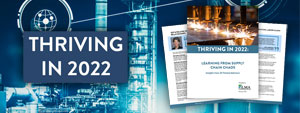
According to Interos, almost 90% of companies experienced a negative impact to revenue due to supply chain disruption. That is a BIG number! From our point-of-view, every client is complaining about the lack of critical resources required to support the business and has experienced negative impacts to revenue (even if only in terms of a delay to revenue recognition).
For example, we have been working with a large manufacturer in the building product industry, and within a year, they have asked us to help them through four unexpected departures of key supply chain and planning resources. Without these key resources, they wouldn’t be able to plan to have the “right” products in the “right” place at the “right” time. In a life science manufacturing client, the reason they asked us to help them design and roll out a S&OP (also known as SIOP) process even though they had a key leader that had successfully implemented SIOP previously is because they were fully occupied in ramping up production to support business growth. They could NOT wait because they had to know which resources to hire, what equipment to procure, and what long-lead time materials to purchase to meet customer demand.
Which clients are attracting people (employees, supply chain partners, trusted advisors) and/or keeping people? What are they doing differently?

What Attracts People to Your Company?
The good news is that what attracts people to your company is clear. The bad news is that it isn’t a “no brainer” to make it happen. The bottom line is that people follow people; not companies.
Start by thinking about whether your people are engaged. In observing clients on a daily basis, it is clear what matters to employees:
- Listen: Does leadership listen to them? NOT just when they are saying something management wants to hear but also when they bring up potential issues….
- Request input: Does anyone ask for opinions, concerns, and feedback? Some employees will speak up regardless, but others will only respond only if asked AND if they think the requestor really wants to know and cares about the answer.
- Communicate the vision: Employees want to understand where they are going and to be excited about where they are going.
- Show how they fit in: Knowing where the company is going isn’t enough. It is important for each person to see how he/she will add value to that vision.
- Show you care: Who doesn’t prefer to spend time to help people who care?
- Have fun: Who wouldn’t prefer to work with someone who adds humor into the conversation or can make boring topics more interesting?
- Treat others as you’d like to be treated: Sounds apparent but doesn’t always occur even with solid leaders.
- Appreciate people: A simple thank you goes a long way. At times, it is also appropriate to recognize people with a bit more pomp and circumstance.
- Don’t overreact: People want to follow people who are confident and calmly resolve issues and overcome obstacles. If you overreact, people remember and will not bring up ideas or issues the next time around.
- Share credit; take the blame: It is surprising how many leaders get this backwards. People pick up on someone interested in his/her career as a #1 priority. They will not be fully engaged.
Even as a consultant, these points matter. Of course, we deliberately focus on results and “stay above the fray”; thus, we will do what’s required no matter the leadership styles. We will typically work with several leaders in a single client especially with cross-functional and cross-organizational projects such as S&OP (also known as SIOP), and so we work with people on both ends of the spectrum as well as in the middle. However, it is FAR more pleasant and engaging to work with clients who follow these guidelines than the ones who don’t. As the Great Resignation and Reshuffle has occurred, it certainly highlighted the difference.
Please keep us in the loop of your situation and how we can help your organization thrive during these times of volatility and disruption. There will be more winners created than at any other time than since emerging from the Great Depression. To gain additional ideas and insights on how to best navigate these volatile times and thrive, read our new eBook Thriving in 2022. Learning from Supply Chain Chaos. Download your complimentary copy.



